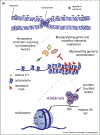Role of H3K9me3 heterochromatin in cell identity establishment and maintenance
- PMID: 31103921
- PMCID: PMC6759373
- DOI: 10.1016/j.gde.2019.04.013
Role of H3K9me3 heterochromatin in cell identity establishment and maintenance
Abstract
Compacted, transcriptionally repressed chromatin, referred to as heterochromatin, represents a major fraction of the higher eukaryotic genome and exerts pivotal functions of silencing repetitive elements, maintenance of genome stability, and control of gene expression. Among the different histone post-translational modifications (PTMs) associated with heterochromatin, tri-methylation of lysine 9 on histone H3 (H3K9me3) is gaining increased attention. Besides its known role in repressing repetitive elements and non-coding portions of the genome, recent observations indicate H3K9me3 as an important player in silencing lineage-inappropriate genes. The ability of H3K9me3 to influence cell identity challenges the original concept of H3K9me3-marked heterochromatin as mainly a constitutive type of chromatin and provides a further level of understanding of how to modulate cell fate control. Here, we summarize the role of H3K9me3 marked heterochromatin and its dynamics in establishing and maintaining cellular identity.
Copyright © 2019 Elsevier Ltd. All rights reserved.
Conflict of interest statement
Conflict of interest
The authors declare no conflict of interest.
Figures



Similar articles
-
H3K9me3-Dependent Heterochromatin: Barrier to Cell Fate Changes.Trends Genet. 2016 Jan;32(1):29-41. doi: 10.1016/j.tig.2015.11.001. Epub 2015 Dec 8. Trends Genet. 2016. PMID: 26675384 Free PMC article. Review.
-
Reprogramming of H3K9me3-dependent heterochromatin during mammalian embryo development.Nat Cell Biol. 2018 May;20(5):620-631. doi: 10.1038/s41556-018-0093-4. Epub 2018 Apr 23. Nat Cell Biol. 2018. PMID: 29686265
-
The control of gene expression and cell identity by H3K9 trimethylation.Development. 2019 Sep 20;146(19):dev181180. doi: 10.1242/dev.181180. Development. 2019. PMID: 31540910 Free PMC article. Review.
-
H3K9me3-heterochromatin loss at protein-coding genes enables developmental lineage specification.Science. 2019 Jan 18;363(6424):294-297. doi: 10.1126/science.aau0583. Epub 2019 Jan 3. Science. 2019. PMID: 30606806 Free PMC article.
-
The molecular basis of heterochromatin assembly and epigenetic inheritance.Mol Cell. 2023 Jun 1;83(11):1767-1785. doi: 10.1016/j.molcel.2023.04.020. Epub 2023 May 18. Mol Cell. 2023. PMID: 37207657 Free PMC article. Review.
Cited by
-
PRC2-mediated repression is essential to maintain identity and function of differentiated dopaminergic and serotonergic neurons.Sci Adv. 2022 Aug 26;8(34):eabo1543. doi: 10.1126/sciadv.abo1543. Epub 2022 Aug 26. Sci Adv. 2022. PMID: 36026451 Free PMC article.
-
Sequence Composition Underlying Centromeric and Heterochromatic Genome Compartments of the Pacific Oyster Crassostrea gigas.Genes (Basel). 2020 Jun 24;11(6):695. doi: 10.3390/genes11060695. Genes (Basel). 2020. PMID: 32599860 Free PMC article.
-
Heterochromatin: did H3K9 methylation evolve to tame transposons?Genome Biol. 2021 Dec 3;22(1):325. doi: 10.1186/s13059-021-02550-5. Genome Biol. 2021. PMID: 34857038 Free PMC article. No abstract available.
-
Biophysical Properties of HP1-Mediated Heterochromatin.Cold Spring Harb Symp Quant Biol. 2019;84:217-225. doi: 10.1101/sqb.2019.84.040360. Epub 2020 Jun 3. Cold Spring Harb Symp Quant Biol. 2019. PMID: 32493764 Free PMC article.
-
Nuclear actin structure regulates chromatin accessibility.Nat Commun. 2024 May 15;15(1):4095. doi: 10.1038/s41467-024-48580-y. Nat Commun. 2024. PMID: 38750021 Free PMC article.
References
Publication types
MeSH terms
Substances
Grants and funding
LinkOut - more resources
Full Text Sources
Other Literature Sources
Miscellaneous

